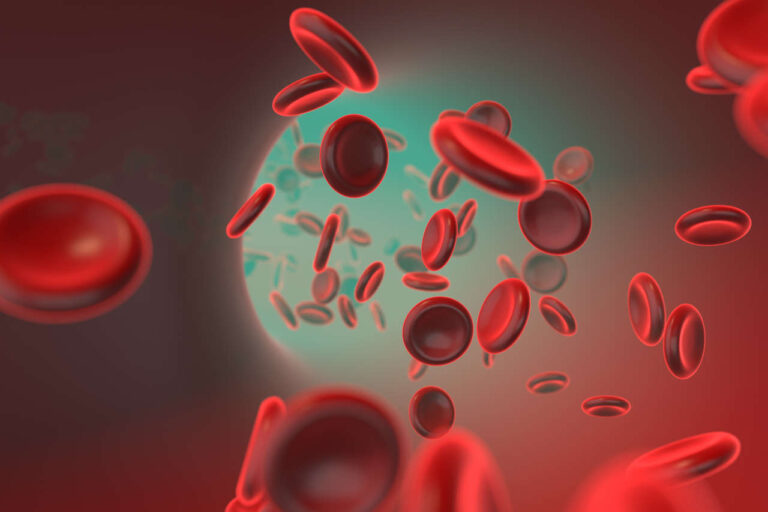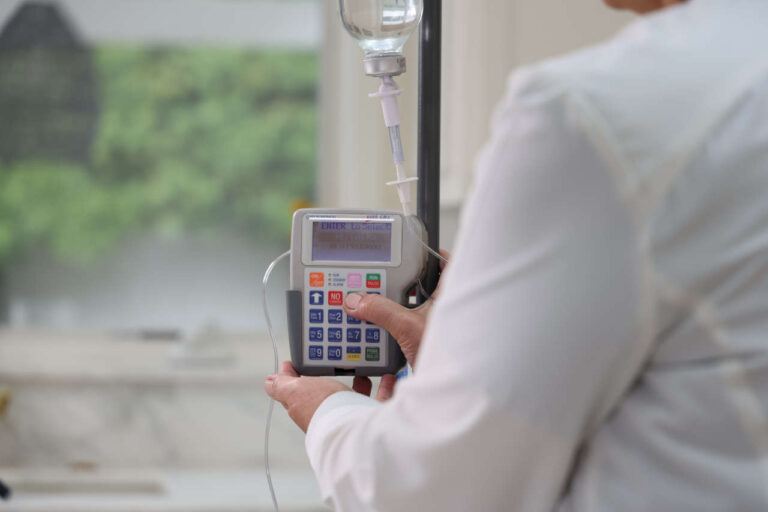
Gamunex is an antibody solution extracted from human blood. Patients with a weak immune system or immune disorder receive infusions of this solution to decrease risk of infections and treat neurological symptoms.
What Is Gamunex?
Generic Name: Immune globulin intravenous (human), 10% Caprylate/Chromatography Purified, 10% Liquid Preparation
Brand Name: Gamunex-C
Class of Drug: Immune globulins
This solution is a mix of immune globulins (antibodies) used for patients suffering from immunodeficiencies and neurological conditions. There are several conditions in which patients lack an optimal working immune system that can produce antibodies to keep them safe from infections.
In such cases, Gamunex acts as an external source of antibodies that can boost the immune system.
Get IVIG Copay Assistance
IVIG Financial AssistanceWhat Is Inside It?
An injection of this solution contains purified immunoglobulins (Ig). They are made from large pools of human plasma by a combination of cold ethanol fractionation, caprylate precipitation, filtration, and anion exchange chromatography. The addition of glycine achieves isotonicity.
Is It Safe?
Yes. This medication is a well-tolerated sterile solution of immunoglobulins. According to one study, intravenous immunoglobulin preparation (i.e., IGIV-C [Gamunex, 10%]) has good pharmacokinetics and tolerability.
Does It Increase Sugar Levels?
Unlike most antibody preparations, Gamunex-C does not contain sucrose (a type of sugar). Therefore, it does not increase sugar levels.
Does It Cause Weight Gain?

For a person with optimally working kidneys, the solution does not cause weight gain.
However, in cases where kidney function is compromised, there is a chance that a patient might experience kidney disease. This disease can cause sudden and unexplained weight gain, but it is not due to Gamunex infusions.
How Does It Work?
Healthcare professionals administer the antibody liquid via the intravenous or subcutaneous route. These antibodies recognize and fight against harmful bacteria and other microorganisms.
In autoimmune diseases, the antibodies from the injection prevent the body’s immune system from attacking its own cells. This act results in a reduction of cell death and inflammation caused by the auto-antibodies, thereby providing relief from symptoms.
Gamunex-C Storage
Gamunex is commercially available in vials of 1 g, 2.5 g, 5 g, 10 g, 20 g, and 40 g. It has a shelf life of three years when stored between 2 to 8 degrees Celsius (i.e., 36 to 46 degrees Fahrenheit) from the date of manufacture.
Does It Need to Be Stored in a Refrigerator?
Store the solution in the refrigerator for long-term usage. However, you can keep it at room temperature below 25 degrees Celsius for up to six months. If the medication has not been infused after this period, it must be discarded.
Do not freeze Gamunex, and discard any frozen solution.
Can IVIG help?
Free IVIG Treatment Info | Difficulty In Diagnosing?What Is Gamunex-C Used For?
This medication is used to treat the following conditions:
Primary Immunodeficiency (PI)
Primary humoral immunodeficiency disease (PID) is a condition characterized by frequent infections. These infections occur due to a deficiency of some classes of immunoglobulins.
IVIG therapies (intravenous immune globulins) are effective in the treatment of immunodeficiencies. The most common IVIG medications include Privigen, Gammaked, Gammaplex, Hizentra, and Gamunex.
Research shows that immunoglobulin replacement therapy is critical in many PIDs that affect antibody production. Immunoglobulin replacement therapy with Gamunex-C was found effective for adults and children with primary immunodeficiency diseases.
Pediatric PID patients can also benefit from IgG therapy via the infusion of this medication.
Congenital Agammaglobulinemia
Immunoglobulin therapy may alleviate symptoms of congenital agammaglobulinemia, such as:
- Fever
- Sinusitis
- Chronic diarrhea
- Otitis media
- Pneumonia
X-Linked Agammaglobulinemia
IgG replacement in patients diagnosed with X-linked agammaglobulinemia can provide symptomatic relief.
This treatment can also reduce the incidence of pneumonia and hospital admission in patients with agammaglobulinemia.
Wiskott-Aldrich Syndrome
The FDA has approved IV antibody treatment (including Gamunex) for Wiskott-Aldrich syndrome to treat an abnormal immune system.
Symptoms are eczema (red, irritated skin), and a reduced ability to form clots.
Idiopathic Thrombocytopenic Purpura (ITP)
Intravenous immunoglobulin treatment can treat ITP. Studies show that Gamunex-C for idiopathic thrombocytopenic purpura can improve the prognosis and help alleviate symptoms.
A randomized controlled trial showed that starting intravenous immunoglobulin therapy early on can benefit newly diagnosed idiopathic thrombocytopenic purpura patients.
Chronic Inflammatory Demyelinating Polyneuropathy (CIPD)
Gamunex was the best treatment for chronic inflammatory demyelinating polyneuropathy as shown in a trial. The administration of the solution led to significant improvement in disability scores. The participants also experienced improvements in grip strength in both hands.
The healthy antibodies from the solution block the immune and inflammatory processes that destroy the myelin sheath, resulting in improvement of symptoms.
Patients can see results in as little as three weeks from the start of therapy. Research has found IVIG therapy to be effective in improving motor symptoms of CIPD.
COVID-19
Individuals suffering from immune system disorders are more prone to COVID-19 infection. A 2020 study showed that Gamunex contains antibodies that are effective against SARS-CoV-2 (a virus that can lead to COVID-19).
High doses of IVIG (Gamunex-C) may also improve symptoms in children suffering from severe coronavirus infection. However, there is a lack of evidence on its safety and tolerability.
One report noted that early administration of IVIG is beneficial for improving immunodeficiency symptoms. In addition to its role in treating immunodeficient patients, immune globulins can be cross-reactive with COVID-19.
Contraindications of Gamunex
Infusion of this medication is contraindicated in the following cases and should be referred to a healthcare professional for evaluation:
History of Thrombosis
People who have suffered thrombosis or are at a higher risk of developing the disease should not receive the infusions. The risk factors include:
- High levels of cholesterol in the body
- Diabetes
- Family history of arterial thrombosis
- Obesity
- Poor diet
- Advanced age
Get Your IVIG Dose – At-Home Infusion
Presence of Underlying Cardiovascular Disease
As thrombosis is a likely adverse outcome of IVIG therapy, patients having underlying heart issues should not take Gamunex. Use caution when administering to patients 65 years and over.
Some IVIG solutions contain high quantities of sodium. Therefore, physicians should prescribe cautiously in patients with cardiac conditions and hypertension.
Blood Circulatory and Renal Disorder
Patients suffering from blood circulatory disorders should also avoid IVIG therapies such as Gamunex-C.
Kidney problems may accompany human immune globulin use. Added sugars to the solution can increase the risk of renal dysfunction. Gamunex does not contain any added sugars and therefore is a safer option for patients with renal function concerns.
However, patients with a severe renal dysfunction must avoid Gamunex as it can cause osmotic nephropathy.
IgA Deficiency
IgA-deficient patients with antibodies against IgA and a history of hypersensitivity should not use this medication as it may result in an anaphylactic reaction.
Allergic Reaction
Individuals with hypersensitive allergic responses to transfusions must not try any IVIG therapy. The anaphylactic reactions can occur after the administration of immune globulins.
Ask About IVIG Home Infusion
Gamunex Infusion/Administration
Injection of immune globulin 10% caprylate can be given into a vein or under the skin.
IV Infusion
For intravenous infusion, the liquid is given just like other IVIG therapies with a pump. The IV route is for the treatment of:
- Primary immunodeficiencies (PI)
- Immune thrombocytopenic purpura (ITP)
- Chronic inflammatory demyelinating polyneuropathy (CIDP)
Note: You should not inject Gamunex-C intravenously if your doctor has instructed you to use a subcutaneous infusion.
Subcutaneous Infusion
A Gamunex infusion pump injects the solution under the skin. Patients must draw the medication into a syringe and then place it into the infusion pump. Subcutaneous infusion can be given at different sites of the body simultaneously.
Infusion Protocols
- The length of the infusion depends on the diagnosis and dose prescribed.
- You must follow the doctor’s instructions if infusing the solution at home.
- It must be given slowly (IV or subcutaneously).
- Do not shake the medication bottle.
- Prepare a dose only when ready to receive the injection (immediate use).
- Do not mix other medications with Gamunex in the same infusion.
- Get frequent blood tests to check for antibody titers.
- Vials are for single use; discard the vial after use.
- Do not freeze the solution.
- Do not self-inject if you don’t fully understand the procedure.
Infusions can be provided through different catheters. Your healthcare provider will inform you of the best locations for subcutaneous Gamunex-C infusion.
All the infusion supplies (needle, catheter, and tubing) are designed for one-time use only and must be discarded after use.
Goals in Administration of Gamunex
Dosage and Infusion Rate
As per FDA guidelines, the infusion rate of this medication for PI must be as follows:
| Route of Administration | Dose | Initial Infusion Rate | Maintenance Infusion Rate |
|---|---|---|---|
| IV (Intravenous) | 300-600 mg/kg | 1 mg/kg/min | 8 mg/kg/min Every 3 to 4 weeks |
| Subcutaneous (SC) | 1.37 x current IV dose in grams/IV Dose interval in weeks | Adult: 20 mL/hr/site Pediatric: 10 mL/hr/site to 15 mL/hr/site | Adult: 20 mL/hr/site Pediatric: 10 mL/hr/site to 20 mL/hr/site Every week |
The infusion rate for ITP and CIPD should be as follows:
| Indication | Dosage | Initial Infusion Rate | Maintenance Infusion Rate |
|---|---|---|---|
| ITP | 2 g/kg | 1 mg/kg/min | 8 mg/kg/min |
| CIPD | Loading dose 2 g/kg Maintenance dose 1 g/kg | 2 mg/kg/min | 8 mg/kg/min Every 3 weeks |
Showing 1 to 2 of 2 entries
Note: The infusion rates for maintenance infusions only apply if the patients tolerate the infusion speed.
Treatment Info
Get IVIG Prior AuthorizationPrecautions of Use
Gamunex should be used cautiously by:
Pregnant Women
Studies suggest IVIG therapy can benefit pregnant mothers and women suffering from recurrent pregnancy loss (RPL). However, injected antibodies may interfere with fetal growth. Therefore, doctors should prescribe IVIG therapy for pregnant women with caution.
Lactating Mothers
There is no information regarding the presence of Gamunex-C in human milk. Therefore, lactating women should use it with caution.
Cost of Gamunex
The price varies from pharmacy to pharmacy. But on average, 10 ml of Gamunex-C (10%) injectable solution costs around $165.86. The 25 ml and 50 ml preparations will cost you about $399.64 and $789.29, respectively.
Copay Assistance
Different companies offer copay assistance and financial support programs. With these programs, you can save up to $2,500 a year.
You can benefit from the patient assistance programs if you’re suffering from CIDP, PIDD, or other conditions for which Gamunex is beneficial. Visit our copay assistance page for Gamunex to learn more.
Warnings
You should discontinue using this medication and call your doctor if you experience the following signs:
Allergic Response
The following signs may appear on the site of infusion and other parts of the body:
- Rash
- Redness and itching of the skin
- Formation of blisters
- Swelling of the mouth, lips, face, or tongue
- Breathing difficulties
Get IVIG Copay Assistance
Speak to a SpecialistRenal Function Disruption
IVIG and subcutaneous administration of Gamunex-C can compromise renal function. The initial signs include:
- Inability to urinate
- Changes in urine color and quantity
Inform your doctor of these warning signs as soon as possible.
Changes in Blood Pressure
Hypertension or an increase of blood pressure can occur following Gamunex infusion. Some patients also experience a decrease in blood pressure. An increase in blood pressure can result in blood clots. Stop the treatment and notify a doctor if you experience headache or dizziness from an Ig infusion.
Lung Issues
Infusions may cause temporary injury to your lungs. Inform your doctor about any breathing issues, such as shortness of breath or difficulty breathing.
Fever and Fatigue
You may experience fatigue and fever due to infusion related reactions temporarily after your infusion. Premedications may be taken prior to infusions to decrease the incidence of infusion related reactions.
Psychological Symptoms
You should report symptoms such as seizures and delirium (feeling confused) as soon as possible. This may be caused by high doses or rapid infusions.
Gamunex-C Dosing Information
Gamunex-C is available as: 10 ml, 25 ml, 50 ml, 100 ml, 200 ml, and 400 ml single-dose, ready-to-use vials containing 0.1 g/ml.
Primary Humoral Immunodeficiency (PI)
Gamunex-C can be given as an infusion into the veins (intravenous or IV) or under the skin (subcutaneous or SC) for PI:
Intravenous (IV):
Dose: The dose is 0.3 g/kg to 0.6 g/kg once every 3 to 4 weeks.
Infusion Rate: The starting infusion rate is 1 mg/kg/min (or 0.01 ml/kg/min). If there aren’t any infusion-related reactions, the rate can be slowly increased to a maximum of 8 mg/kg/min (0.08 ml/kg/min).
Subcutaneous (SC):
Dose: A patient must receive intravenous immunoglobulin (IVIG) therapy before starting Gamunex-C SC infusions. The starting weekly Gamunex-C SC dose is calculated by dividing the previous IVIG dose in grams by the number of weeks between doses, then multiplying by 1.37. For example, if the IVIG dose was 20 grams once every 4 weeks, the weekly Gamunex-C dose would be calculated as follows: 20 divided by 4, then multiplied by 1.37, which equals 6.8 g (round to 7 g) of Gamunex-C once per week. Dosing for Gamunex-C when switching from a subcutaneous Ig hasn’t been studied and dosing should be guided based on serum immunoglobulin G (IgG) levels.
Site of Administration: The sites of administration are the stomach, thigh, upper arm, side of the hip, and lower back. Use a different infusion site from the previous infusion site with every dose. Additionally, up to 8 infusion sites for adults and up to 6 infusion sites for children can be used at the same time. Make sure each infusion site is at least 2 inches apart from each other.
Infusion Rate: The infusion rate is 20 ml/hour per infusion site for adults. Children and adolescents weighing at least 25 kg (55 pounds) should start at 15 ml/hr per infusion site and increase to 20 ml/hr as tolerated. For children and adolescents weighing less than 25 kg (55 pounds), a rate of 10 ml/hr per infusion site is recommended.
After 2 to 3 months of receiving Gamunex-C, the dose can be adjusted based on clinical response and serum IgG levels.
Idiopathic Thrombocytopenic Purpura (ITP)
Gamunex-C can only be given as an intravenous infusion for ITP.
Dose: The total dose is 2 g/kg, given as either a high-dose regimen of 1 g/kg once daily for 2 days or 0.4 g/kg once daily for 5 days. The second dose of the high-dose regimen can be held if there’s an adequate platelet count response 24 hours after the first dose. The high-dose regimen isn’t recommended for people where high fluid volume is a concern (e.g., heart failure, kidney dysfunction).
Infusion Rate: The starting infusion rate is 1 mg/kg/min (or 0.01 ml/kg/min). If there aren’t any infusion-related reactions, the rate can be slowly increased to a maximum of 8 mg/kg/min (0.08 ml/kg/min).
Chronic Inflammatory Demyelinating Polyneuropathy (CIDP)
Gamunex-C can only be given as an IV infusion for CIDP.
Dose: The dose is a 2 g/kg loading dose, which is given over 2 to 4 days, then a maintenance dose of either 1 g/kg once daily for 1 day or 0.5 g/kg once daily for 2 days every 3 weeks for 2 doses. Based on the response, continued maintenance treatment after 6 months might not be necessary.
Infusion Rate: The starting infusion rate is 2 mg/kg/min (or 0.02 ml/kg/min). If there aren’t any infusion-related reactions, the rate can be slowly increased to a maximum of 8 mg/kg/min (0.08 ml/kg/min).
Side Effects of Gamunex

This medication is generally a well-tolerated and safe solution to be injected into the vein or under the skin. However, it has some side effects, ranging from mild rashes to life-threatening issues such as renal failure.
Common Side Effects
Most side effects occur on the infusion site, and they are manageable. The most commonly encountered non-serious side effects of Gamunex-C are:
- Rash on the skin accompanied by redness and bruising
- Itching on the injection site
- Pain/stiffness on infusion site
- Runny nose and sore throat (with cough)
- Lethargy and bad moods
- Headache
- Dizziness
- Back pain (and muscle/joint pain)
- Hypertension
According to one study, the most common effects of 10% IVIG caprylate solution were headache, pyrexia (fever), clotting, and vomiting.
Ask an IVIG Specialist
About Side EffectsSerious Side Effects
The most dangerous adverse effects of Gamunex are:
Thrombosis
There is a high risk of thromboembolism (i.e., blood clot formation) following IVIG infusion. IVIG 10% caprylate has a high chance of developing thrombus in the body, but risk can be decreased with a slower infusion rate.
Patients with uncontrolled blood pressure and cardiovascular diagnoses are more at risk for clotting with Gamunex-C. Blood clot formation can eventually lead to complications such as a heart attack, stroke, and heart failure.
Therefore, it is vital to keep the patient hydrated, start treatment with a low dose, and keep the infusion rate low as tolerated.
Renal Failure
Kidney function may be compromised by immune globulin products such as Gamunex. Symptoms may present as edema in the peripherals of the legs, decrease in urination, sudden weight gain, and shortness of breath.
Dehydration is also a side effect of immune globulin therapy. It is important to stay hydrated before and after infusions to protect the kidneys.
Aseptic Meningitis
Inflammation of the meninges of the brain can put your life at risk. Aseptic meningitis is associated with IVIG therapy, but is very rare. Symptoms include fever, neck pain or stiffness, headache, and nausea or vomiting.
Hemolysis (and Anemia)
Breakdown of red blood cells following IVIG infusion can lead to the development of anemia, which is a dangerous complication of Gamunex. Patients with pre-existing anemia and or cardiovascular and pulmonary compromise are at risk for hemolytic anemia.
Hematoma
Do not administer Gamunex-C subcutaneously in patients with ITP. They may develop a blue/black wound (pocket of blood), known as a hematoma.
Transmission of Infections
Because it is an infusion extracted from human blood, there is a possibility of harmful viruses such as variant Creutzfeldt-Jakob disease (vCJD) transferring.
Drug Interactions
Gamunex can interfere with the action of live vaccines (mumps, measles, etc.).
Gamunex-C vs. Other Immune Globulins
Gammagard and Gammaplex
Gammagard and Gammaplex are competitors of the drug.
Privigen
Both Gamunex and Privigen are effective intravenous immunoglobulin replacement therapies for the management of primary humoral immunodeficiencies.
IVIG-SD
According to a randomized, double-blind trial, Gamunex-C is superior to IVIG-SD therapy. This trial tested it in primary immune deficiency patients. It significantly improved acute sinusitis and bronchiectasis. It also had adverse reactions similar to IVIG-SD.
Conclusion
Gamunex-C is a 10% immune globulin solution prepared by caprylate/chromatography. Physicians can administer the antibody solution intravenously or subcutaneously. It performs well in conditions such as PI, CIDP, ITP, and agammaglobulinemia.
Because Gamunex is associated with an increased risk of thrombosis, renal failure, and hemolysis, doctors must prescribe it cautiously.













